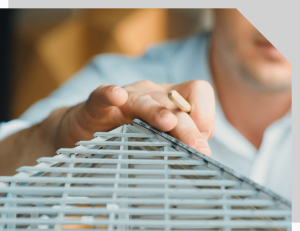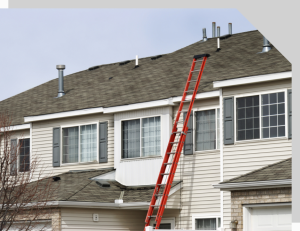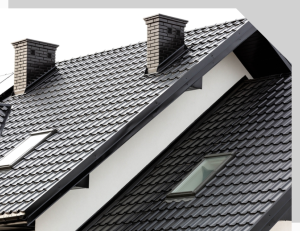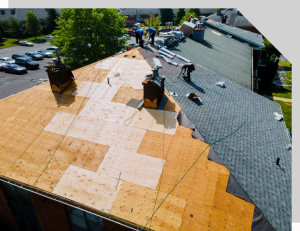Exploring the Advantages and Process of Pitched Roofing with Thunder Bay Roofing in Edgewater, MD
Pitched roofing, a classic and enduring roofing style, has been a staple in the construction industry for centuries. Thunder Bay Roofing, situated in Edgewater, MD, brings a wealth of experience and expertise to the world of pitched roofing.
Led by contractors Steven Perz and Nick Friedman, the team at Thunder Bay Roofing serves Edgewater and the surrounding areas, including Annapolis, Belair, and Laurel, MD. Learn all about the intricacies of pitched roofing by dialing 410-956-7663. If you have any questions, or you need roofing services, trust Thunder Bay Roofing as your number one roofing contractor.
What Is Pitched Roofing?
Pitched roofing refers to a roofing style characterized by a slope or pitch, creating an angled surface. Unlike flat roofs, pitched roofs have a steeper incline, offering a range of design options and functional benefits. This style is often associated with traditional and residential buildings, contributing to their aesthetic appeal.
Types of Pitched Roofs
- Gabled Roof – Classic triangular sloped roof shape at the ends of the house
- Cross-Gabled Roof – Gabled roof with perpendicular gable sections intersecting
- Hipped Roof – Slopes inward from all four exterior walls to create a pyramid-shape
- Mansard Roof – Double sloped roof with nearly vertical lower portion and flatter upper portion
- Gambrel Roof – Double sloped roof with steeper upper pitch and shallower lower pitch
- Dormer Roof – Smaller roofed projection sticking out from the main sloped roof
- Butterfly Roof – Inverted “V” shape with two sides angling down from a central peak
- Bonnet Roof – Two gabled sections sloping down from a central raised portion
- Saltbox Roof – Asymmetrical gabled roof with longer pitched slope in the back
Benefits of Pitched Roofing
Aesthetic Versatility
One of the primary benefits of pitched roofing lies in its aesthetic versatility. The slope allows for various designs, from classic gable roofs to more complex hip or gambrel roofs. Homeowners can choose a style that complements the architectural features of their property.
Effective Water Drainage
The steep slope of pitched roofs ensures efficient water drainage. Rain and snow are less likely to accumulate, reducing the building’s risk of leaks and water damage. This feature is particularly beneficial in areas prone to heavy precipitation.
Longevity and Durability
Pitched roofs are known for their durability and longevity. The materials used in many types of pitched roofing, such as asphalt and metal, are designed to withstand harsh weather conditions, UV exposure, and other environmental factors.
Attic Ventilation
The even roof pitch in pitched roofs facilitates effective attic ventilation. Proper ventilation helps regulate indoor temperature, prevents moisture buildup, and enhances energy efficiency, contributing to a comfortable living environment.
Increased Property Value
Homes with pitched roofs often have higher resale values due to their aesthetic appeal, durability, and the potential for additional living space in the attic. A well-maintained pitched roof adds curb appeal, making the property more attractive to potential buyers.
Possible Disadvantages of Pitched Roofing
Pitched roofs, while aesthetically pleasing, have some potential drawbacks, some of which include the following:
- The steep angle of higher-pitched roofs and even low-pitched roofs can make maintenance and repairs difficult and dangerous
- With higher roof rises, there’s an increased likelihood of snow and ice buildup leading to ice dams or collapse.
- The complex framing on a higher pitch type or roof requires more materials and labor, increasing costs.
- Pitched roofing may not work on some home designs or small lots due to roof height.
- The higher overall material and construction costs may make this type of roof unfeasible for certain individuals.
Take these possible disadvantages into account before deciding on the type of roof you want to invest in. Our contractors will be sure to tell you everything you need to know about pitched roofing during your consultation.
Costs of Pitched Roofing
The main costs associated with higher roof pitch come from the extra materials and complex construction involved. More lumber is required to build the intricate framing for rafters, ridges, and trusses to achieve the sloped angle. In addition to standard roofing materials like shingles or tiles, extra underlayment may be required. The steep angle of roof pitches also makes installation more labor-intensive and risky.
Like all roofing types, pitched roofs require regular maintenance like clearing snow and leaves from gutters, checking for damaged shingles, and re-sealing flashing. The eventual replacement of materials like shingles may be more costly due to the difficulty of working on a sloped roof. Overall, pitched roofs require a greater upfront investment and higher lifetime maintenance costs compared to flat roofs or other roofs.
Best Homes Suited for Pitched Roofing
Pitched roofs work best aesthetically and functionally on certain home styles and settings. The classic gabled roof is most iconic on Colonial, Craftsman, and Cape Cod-style homes. The sloped angles complement the boxy shapes and triangular gables of these homes. Other house styles that commonly feature pitched roofs are Victorian, Tudor, and ranch homes.
Homes in snowy climates are also well-suited for pitched roofs. The angled shape prevents heavy snow accumulation and allows it to slide off more easily. The height and pitch can be adjusted to accommodate anticipated snow loads. Pitched roofs also work well on large, multi-story homes where the roof height is not restricted.
The Pitched Roof Process
Roof Inspection and Planning
Before any installation begins, Thunder Bay Roofing conducts a thorough inspection of the existing roof structure. This step involves assessing the condition of the current roof, identifying any issues, and planning the optimal pitch for the new roof.
Material Selection
Choosing the right roofing material is crucial for the longevity and performance of a pitched roof. Our contractors offer a variety of high-quality materials, including asphalt shingles, metal, cedar shakes, and tiles. The selection is based on factors such as budget, climate, and aesthetic preferences.
Roof Framing
The framing is a critical step in creating a pitched roof structure. Our Edgewater contracting team ensures precise framing to support the weight of the roofing materials and provide the roof’s pitch necessary slope for effective drainage.
Underlayment and Insulation
The underlayment acts as a protective barrier between the roofing material and the roof deck, preventing water infiltration. Insulation is also installed during this phase to enhance energy efficiency and regulate indoor temperature.
Roofing Material Installation
With the foundation in place, Thunder Bay Roofing proceeds to install the selected roofing material. The installation process varies based on the material chosen, with careful attention to detail to ensure a secure and weather-resistant finish.
Flashing and Ventilation
Flashing is applied to vulnerable areas such as chimneys, valleys, and intersections to prevent water penetration. Proper ventilation systems are also installed to promote airflow in the attic, preventing moisture buildup and prolonging the life of the roof.
Final Inspection
Thunder Bay Roofing conducts a final inspection to ensure that every aspect of the pitched roof installation meets its rigorous standards. This step involves checking for proper installation, sealing, and addressing any potential issues.
Frequently Asked Questions
It is advisable to have your pitched roof inspected at least once a year, especially before the winter season. Regular inspections help identify and address any issues promptly, extending the lifespan of the roof.
Yes, pitched roof types are ideal for solar panel installations. The angle of the roof’s pitch allows for optimal sunlight exposure, maximizing the efficiency of solar panels.
Factors to consider include climate, budget, desired aesthetic, and the lifespan of the chosen material. Your contractor will provide guidance to help you make informed decisions.
Yes, pitched roof types offer the advantage of creating usable attic space. With proper insulation and ventilation, attics can be converted into comfortable living areas, adding value to the property.



